
stable-pi-core
Stable-Pi-Core is a next-generation decentralized ecosystem that integrates blockchain, quantum AI, IoT, edge computing, and AR/VR to deliver secure, scalable, and personalized solutions for payments, governance, and real-world applications—redefining the future of technology with unmatched flexibility and innovation.
Stars: 84
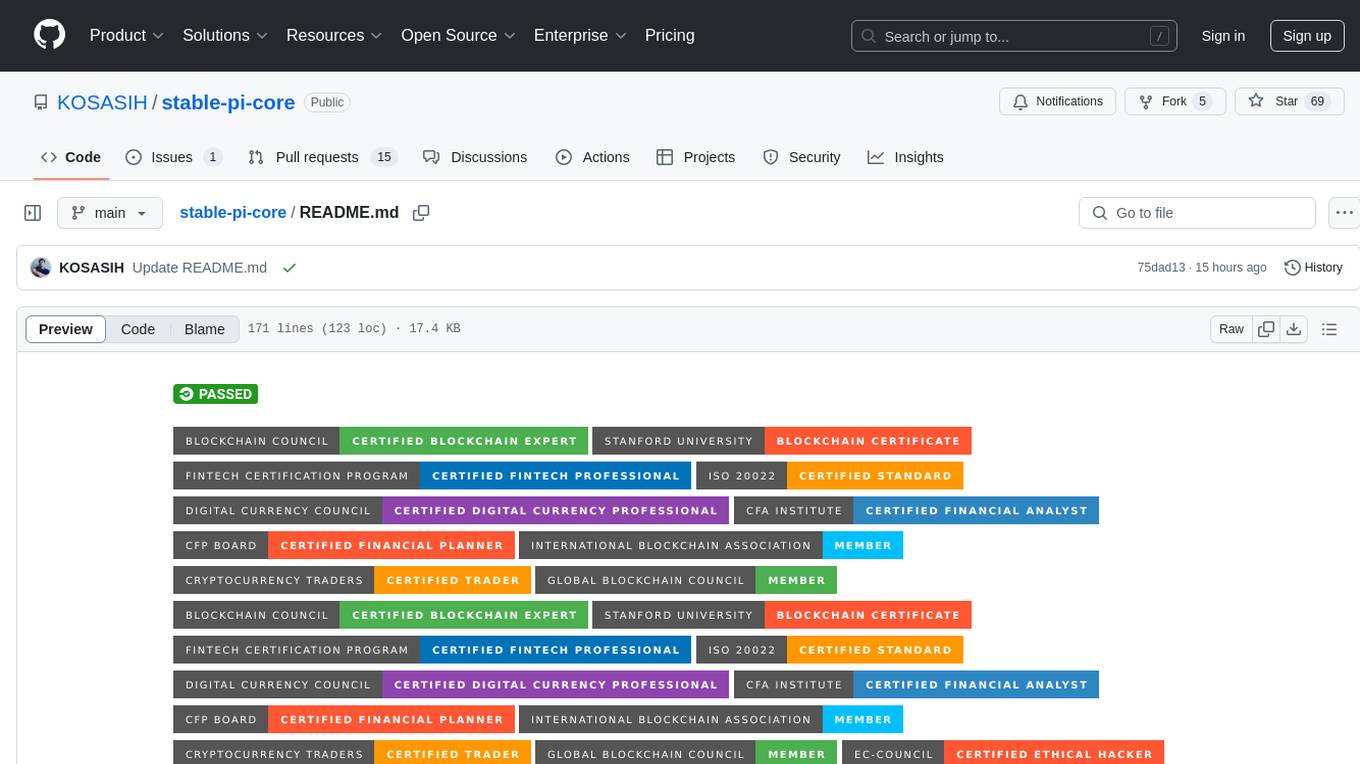
Stable-Pi-Core is a next-generation decentralized ecosystem integrating blockchain, quantum AI, IoT, edge computing, and AR/VR for secure, scalable, and personalized solutions in payments, governance, and real-world applications. It features a Dual-Value System, cross-chain interoperability, AI-powered security, and a self-healing network. The platform empowers seamless payments, decentralized governance via DAO, and real-world applications across industries, bridging digital and physical worlds with innovative features like robotic process automation, machine learning personalization, and a dynamic cross-chain bridge framework.
README:
Stabzer by KOSASIH is licensed under Creative Commons Attribution 4.0 International
Stable-Pi-Core is a next-generation decentralized ecosystem that integrates blockchain, quantum AI, IoT, edge computing, and AR/VR to deliver secure, scalable, and personalized solutions for payments, governance, and real-world applications—redefining the future of technology with unmatched flexibility and innovation.
Stable-Pi-Core is a revolutionary decentralized technology ecosystem designed to push the boundaries of human innovation and expand technological presence throughout the universe. As an independent project with a vision that transcends conventional blockchain, Stable-Pi-Core integrates super-advanced technologies such as quantum physics, dark matter energy, neutrino communication, and intergalactic governance to create a platform unmatched in speed, security, scalability, and utility. With a flexible modular architecture, Stable-Pi-Core does not rely on any specific ecosystem—while capable of synergizing with other networks—and offers solutions for digital economies, real-world applications, and space exploration.
Stable-Pi-Core aims to be the backbone of future technology, connecting humans, machines, and potential civilizations across the solar system and beyond. With a core value pegged at $314159 (three hundred fourteen thousand one hundred fifty-nine) through a Dual-Value System, the project combines economic stability with extreme innovation, supporting interplanetary transactions, decentralized governance, and intergalactic expansion. Stable-Pi-Core is not just a payment platform or blockchain—it is a living ecosystem that evolves to meet the needs of today and tomorrow, from smart cities on Earth to colonies on Mars and beyond.
Stable-Pi-Core offers a range of super-advanced features that make it unique among all current technology projects:
-
Quantum Gravitational Consensus (QGC) & Tachyonic Communication Protocol (TCP)
Quantum and gravitational effect-based consensus, reinforced by faster-than-light tachyon communication, enabling instant transactions and synchronization across terrestrial and interplanetary nodes, even at intergalactic distances. -
Holographic Quantum Ledger (HQL)
A 3D holographic quantum ledger that stores data with unlimited capacity and instant access, supporting massive storage of IoT, market analysis, and space data. -
Dark Matter Energy Converter (DMEC) & Zero-Point Energy Harvesting Module (ZPEHM)
Revolutionary energy sources from dark matter and quantum fluctuations, providing unlimited power for nodes on Earth and in space, ensuring autonomous operation in extreme environments. -
Photonic Quantum Processor Network (PQPN)
A network of photonic-based quantum processors distributed across satellites and edge nodes, processing Quantum-AI analytics and AR/VR rendering with unparalleled speed and efficiency. -
Neutrino-Based Communication Array (NBCA)
Neutrino-based communication that penetrates matter, ensuring absolute connectivity between Earth, orbit, and interplanetary colonies without physical barriers. -
Interplanetary Transaction Protocol (ITP) & Galactic Governance Framework (GGF)
Cross-planet transaction protocols and a galactic governance framework, enabling payments and DAO management across the solar system with precision time synchronization and interplanetary voting. -
Exo-Blockchain Synchronization (EBS)
A synchronization system for communication with hypothetical foreign blockchains, preparing Stable-Pi-Core for intergalactic contact and interaction with extraterrestrial civilizations. -
Cosmic Radiation Hardened AI (CRHAI) & Astro-Quantum Privacy Shield (AQPS)
Cosmic radiation-hardened AI and satellite-based quantum privacy layers, protecting data and operations in space environments with absolute security. -
Orbital Data Marketplace (ODM)
An orbital-based data marketplace for trading space information (e.g., satellite telemetry, cosmic climate data), expanding the Stable-Pi-Core economy into space.
- Dual-Value System: Economic stability with a value pegged at $314159 (three hundred fourteen thousand one hundred fifty-nine), supported by a Dynamic Liquidity Pool System.
- Multi-Currency Payment System: Cross-currency transactions (crypto and fiat) with seamless conversion.
- IoT Integration & Edge Computing: Connectivity and local processing for real-world applications.
- AR-VR Experience: Immersive interfaces for users and governance.
- Machine Learning Personalization: Adaptive and intelligent user experiences.
Stable-Pi-Core is built on a flexible modular blockchain architecture, reinforced by a Space-Based Node Network that extends to Earth’s orbit and beyond. With a Self-Healing Network Protocol and Adaptive Consensus Mechanism, the platform is resilient against both terrestrial and cosmic disruptions. Integration of technologies such as quantum entanglement, photonics, and neutrinos makes Stable-Pi-Core not only fast and secure but also ready for intergalactic expansion. The Token Incentive System and DAO ensure active community participation, while the Cross-Chain Bridge Framework allows interoperability with other blockchains without dependencies.
Stable-Pi-Core supports a wide range of applications, including:
- Digital Economy: Cross-chain and interplanetary payments with zero latency, from IoT microtransactions to galactic trade.
- Decentralized Governance: Community management on Earth, Mars, or beyond through the Galactic Governance Framework.
- Space Exploration: Orbital data marketplaces, interplanetary communication, and infrastructure for space colonies.
- Scientific Innovation: Providing a platform for astrophysics research, bioeconomics, and intergalactic contact.
With these capabilities, Stable-Pi-Core has the potential to transform how humanity interacts with technology, the economy, and the universe, establishing a foundation for a future of intergalactic exploration.
Stable-Pi-Core is an independent project that stands alone, not officially affiliated with Pi Network or any other ecosystem. While it may be inspired by the initial concept of Pi, Stable-Pi-Core has evolved into a far more advanced entity, focusing on intergalactic technology and extreme innovation that surpasses the scope of traditional blockchain projects. With its unique features, Stable-Pi-Core sets a new standard for what decentralized technology can achieve.
Stable-Pi-Core aims not only to be a leader on Earth but also a pioneer in intergalactic exploration and life. With the ability to support transactions, governance, and communication across the solar system—and even to extraterrestrial civilizations—this project offers a vision of a future where decentralized technology serves as a bridge between humanity and the universe. Stable-Pi-Core is a legacy of innovation ready to propel humanity into a new era of exploration, connectivity, and technological advancement.
- Python 3.x
- Node.js (for smart contract development)
- Docker (for containerization)
-
Clone the repository:
1 git clone https://github.com/KOSASIH/stable-pi-core.git 2 cd stable-pi-core -
Install dependencies:
1 pip install -r requirements.txt
-
Set up the environment:
1 ./setup_environment.sh
To run the application, use the following command:
1 python src/api/app.pyWe welcome contributions! Please see the CONTRIBUTING.md for guidelines.
This project is licensed under the MIT and GALACTIC UNION License. See the MIT LICENSE and GALACTIC UNION file for details.
Special thanks to the contributors and the community for their support and feedback.
For Tasks:
Click tags to check more tools for each tasksFor Jobs:
Alternative AI tools for stable-pi-core
Similar Open Source Tools

stable-pi-core
Stable-Pi-Core is a next-generation decentralized ecosystem integrating blockchain, quantum AI, IoT, edge computing, and AR/VR for secure, scalable, and personalized solutions in payments, governance, and real-world applications. It features a Dual-Value System, cross-chain interoperability, AI-powered security, and a self-healing network. The platform empowers seamless payments, decentralized governance via DAO, and real-world applications across industries, bridging digital and physical worlds with innovative features like robotic process automation, machine learning personalization, and a dynamic cross-chain bridge framework.

LLM-Powered-RAG-System
LLM-Powered-RAG-System is a comprehensive repository containing frameworks, projects, components, evaluation tools, papers, blogs, and other resources related to Retrieval-Augmented Generation (RAG) systems powered by Large Language Models (LLMs). The repository includes various frameworks for building applications with LLMs, data frameworks, modular graph-based RAG systems, dense retrieval models, and efficient retrieval augmentation and generation frameworks. It also features projects such as personal productivity assistants, knowledge-based platforms, chatbots, question and answer systems, and code assistants. Additionally, the repository provides components for interacting with documents, databases, and optimization methods using ML and LLM technologies. Evaluation frameworks, papers, blogs, and other resources related to RAG systems are also included.
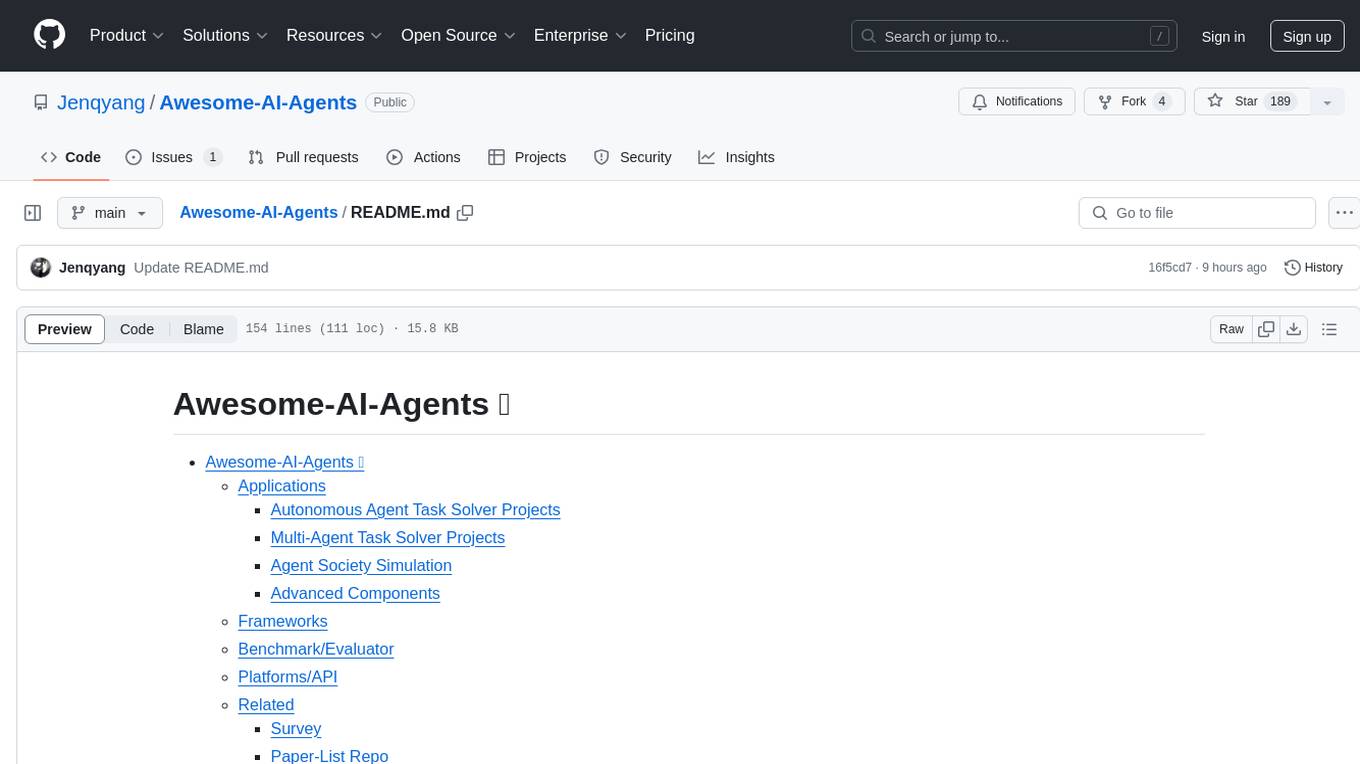
Awesome-AI-Agents
Awesome-AI-Agents is a curated list of projects, frameworks, benchmarks, platforms, and related resources focused on autonomous AI agents powered by Large Language Models (LLMs). The repository showcases a wide range of applications, multi-agent task solver projects, agent society simulations, and advanced components for building and customizing AI agents. It also includes frameworks for orchestrating role-playing, evaluating LLM-as-Agent performance, and connecting LLMs with real-world applications through platforms and APIs. Additionally, the repository features surveys, paper lists, and blogs related to LLM-based autonomous agents, making it a valuable resource for researchers, developers, and enthusiasts in the field of AI.
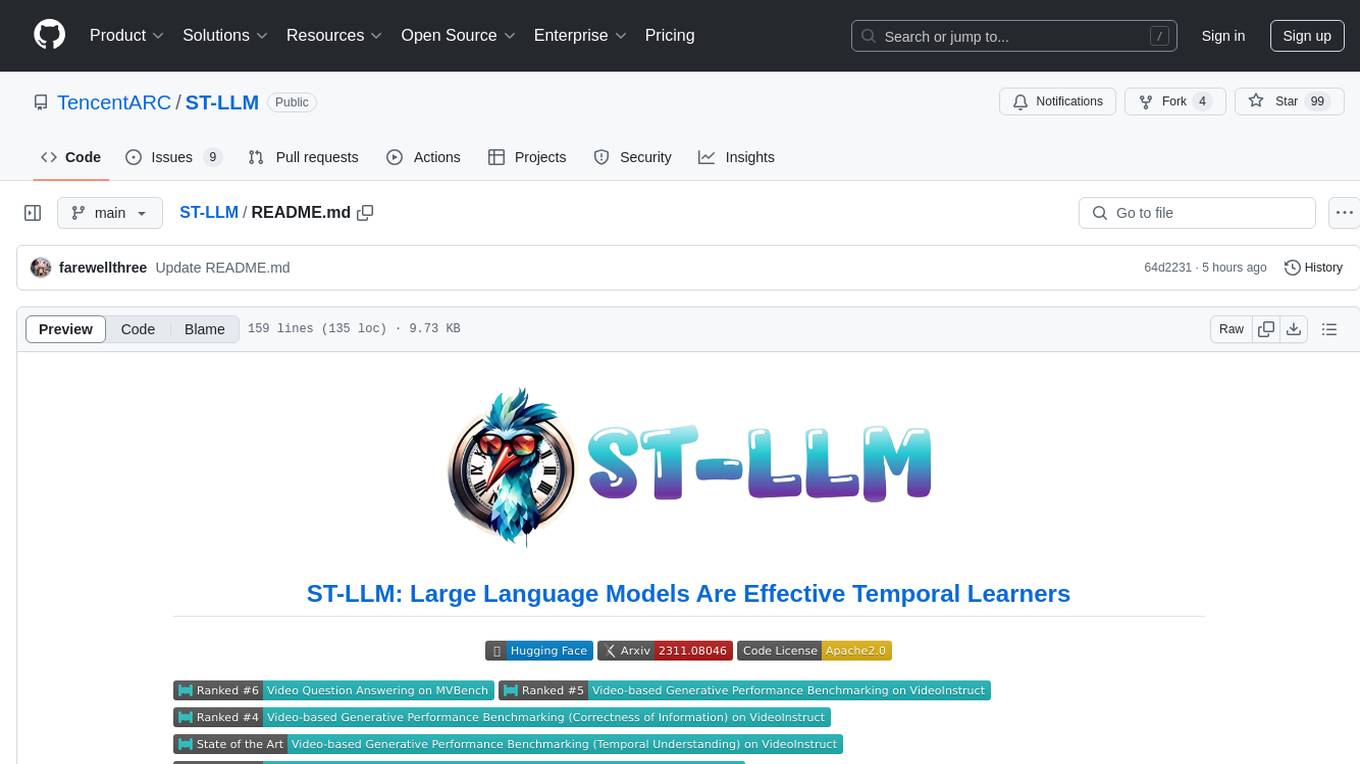
ST-LLM
ST-LLM is a temporal-sensitive video large language model that incorporates joint spatial-temporal modeling, dynamic masking strategy, and global-local input module for effective video understanding. It has achieved state-of-the-art results on various video benchmarks. The repository provides code and weights for the model, along with demo scripts for easy usage. Users can train, validate, and use the model for tasks like video description, action identification, and reasoning.
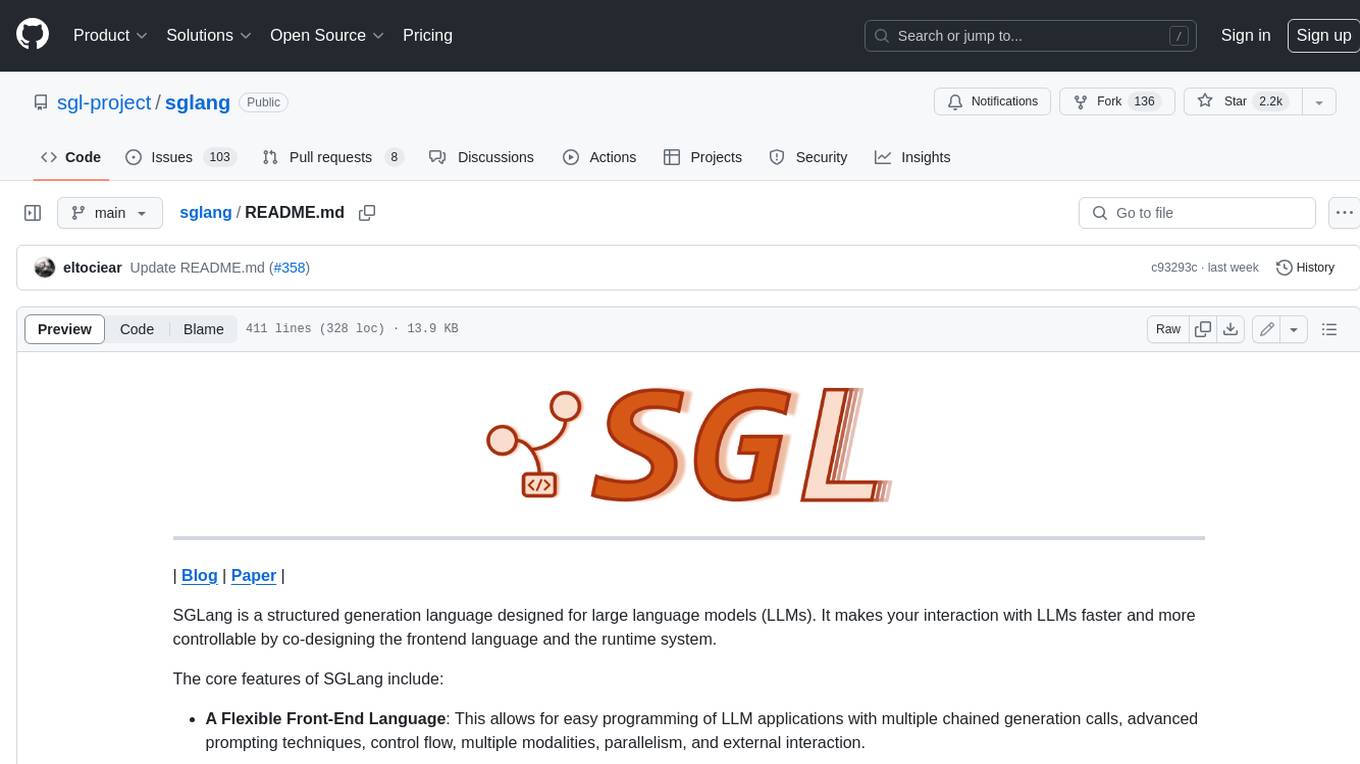
sglang
SGLang is a structured generation language designed for large language models (LLMs). It makes your interaction with LLMs faster and more controllable by co-designing the frontend language and the runtime system. The core features of SGLang include: - **A Flexible Front-End Language**: This allows for easy programming of LLM applications with multiple chained generation calls, advanced prompting techniques, control flow, multiple modalities, parallelism, and external interaction. - **A High-Performance Runtime with RadixAttention**: This feature significantly accelerates the execution of complex LLM programs by automatic KV cache reuse across multiple calls. It also supports other common techniques like continuous batching and tensor parallelism.
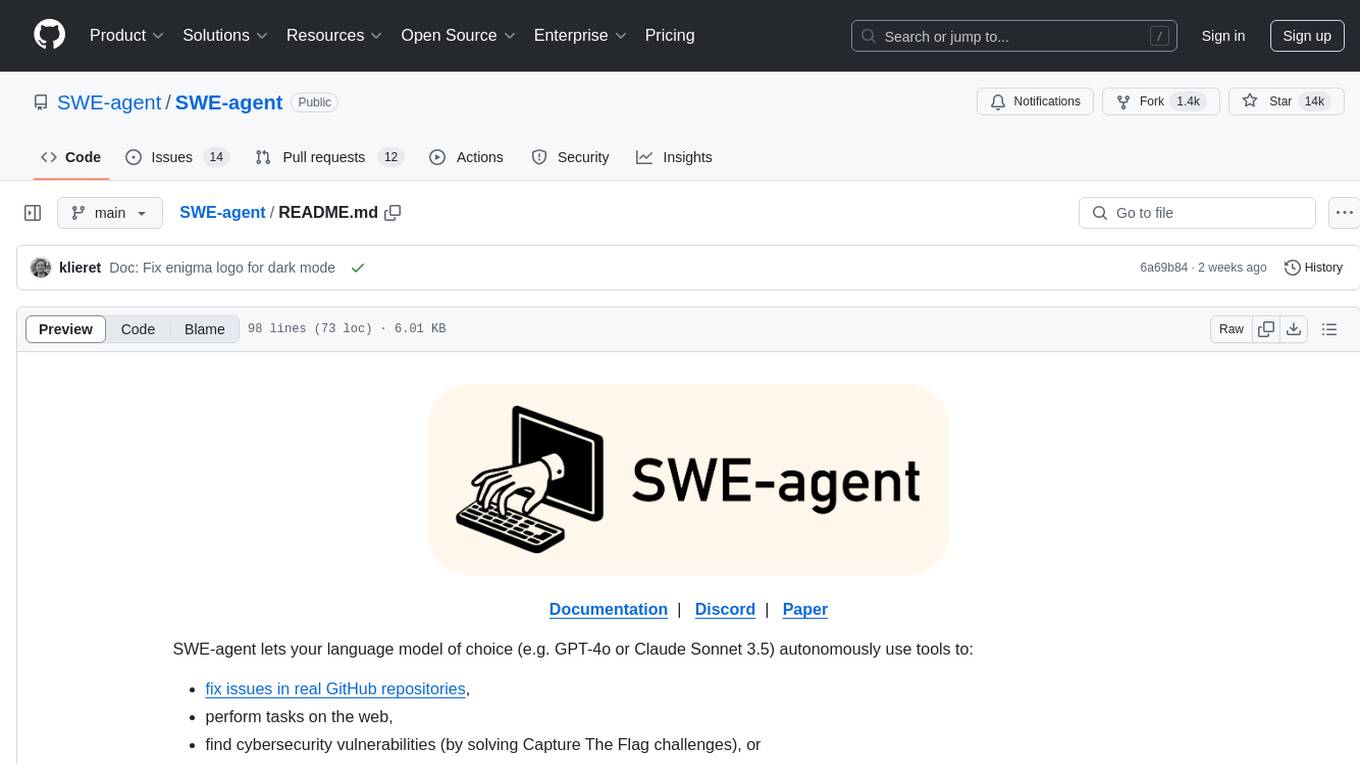
SWE-agent
SWE-agent is a tool that allows language models to autonomously fix issues in GitHub repositories, perform tasks on the web, find cybersecurity vulnerabilities, and handle custom tasks. It uses configurable agent-computer interfaces (ACIs) to interact with isolated computer environments. The tool is built and maintained by researchers from Princeton University and Stanford University.
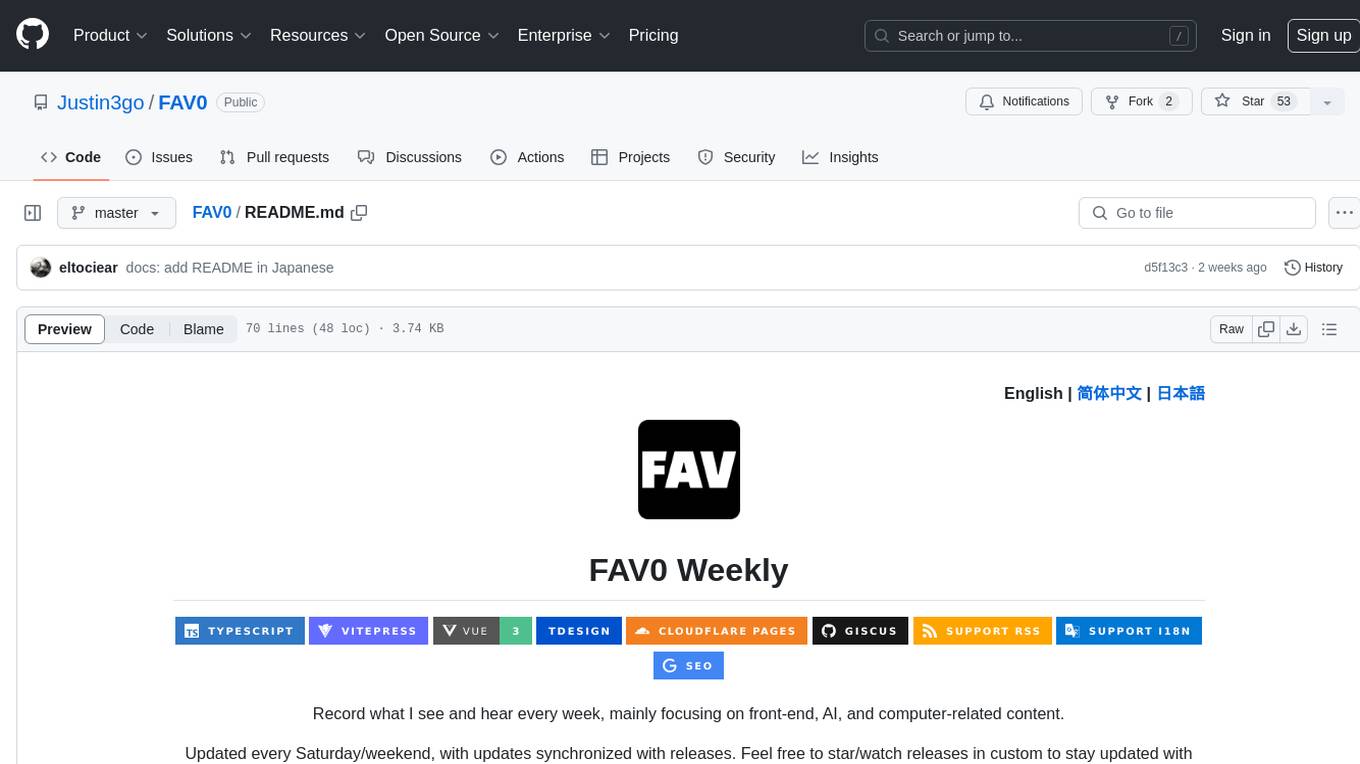
FAV0
FAV0 Weekly is a repository that records weekly updates on front-end, AI, and computer-related content. It provides light and dark mode switching, bilingual interface, RSS subscription function, Giscus comment system, high-definition image preview, font settings customization, and SEO optimization. Users can stay updated with the latest weekly releases by starring/watching the repository. The repository is dual-licensed under the MIT License and CC-BY-4.0 License.

cuckoo
Cuckoo is a Decentralized AI Platform that focuses on GPU-sharing for text-to-image generation and LLM inference. It provides a platform for users to generate images using Telegram or Discord.
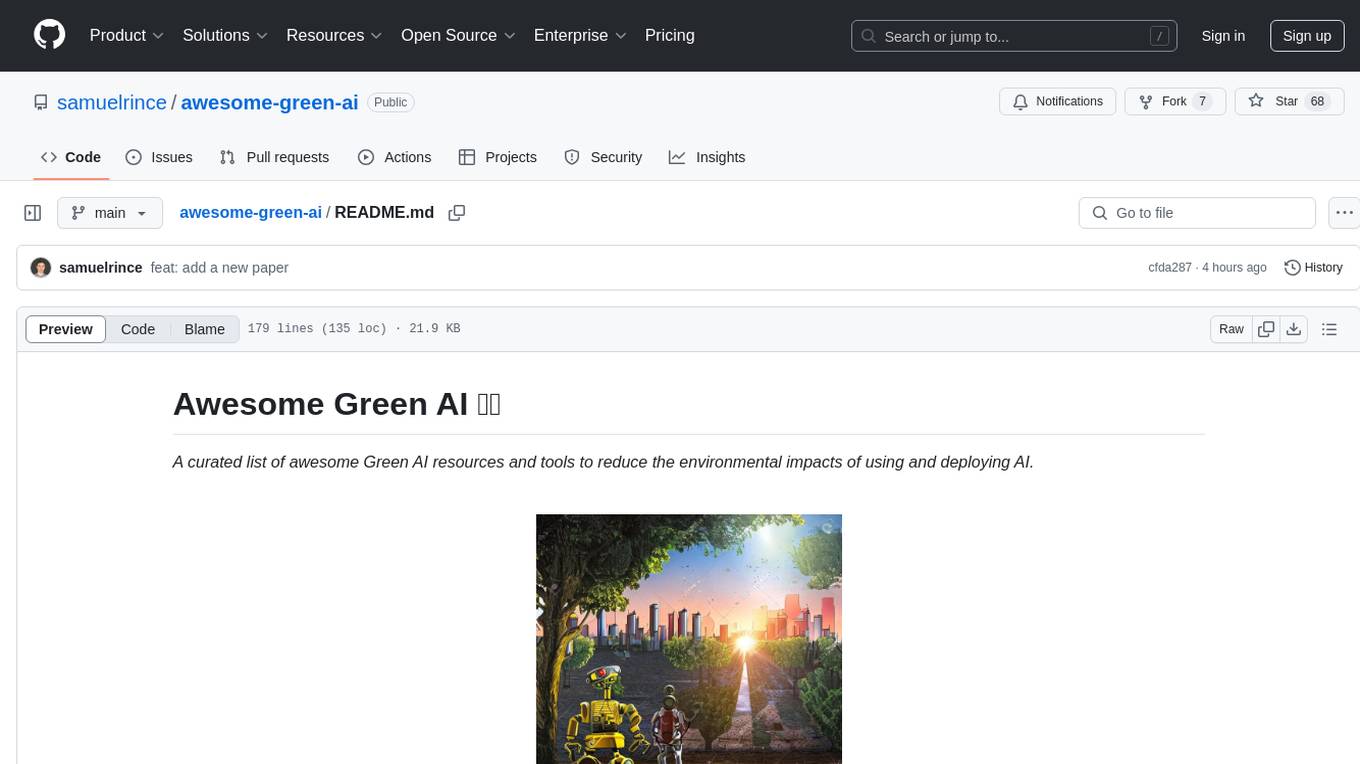
awesome-green-ai
Awesome Green AI is a curated list of resources and tools aimed at reducing the environmental impacts of using and deploying AI. It addresses the carbon footprint of the ICT sector, emphasizing the importance of AI in reducing environmental impacts beyond GHG emissions and electricity consumption. The tools listed cover code-based tools for measuring environmental impacts, monitoring tools for power consumption, optimization tools for energy efficiency, and calculation tools for estimating environmental impacts of algorithms and models. The repository also includes leaderboards, papers, survey papers, and reports related to green AI and environmental sustainability in the AI sector.
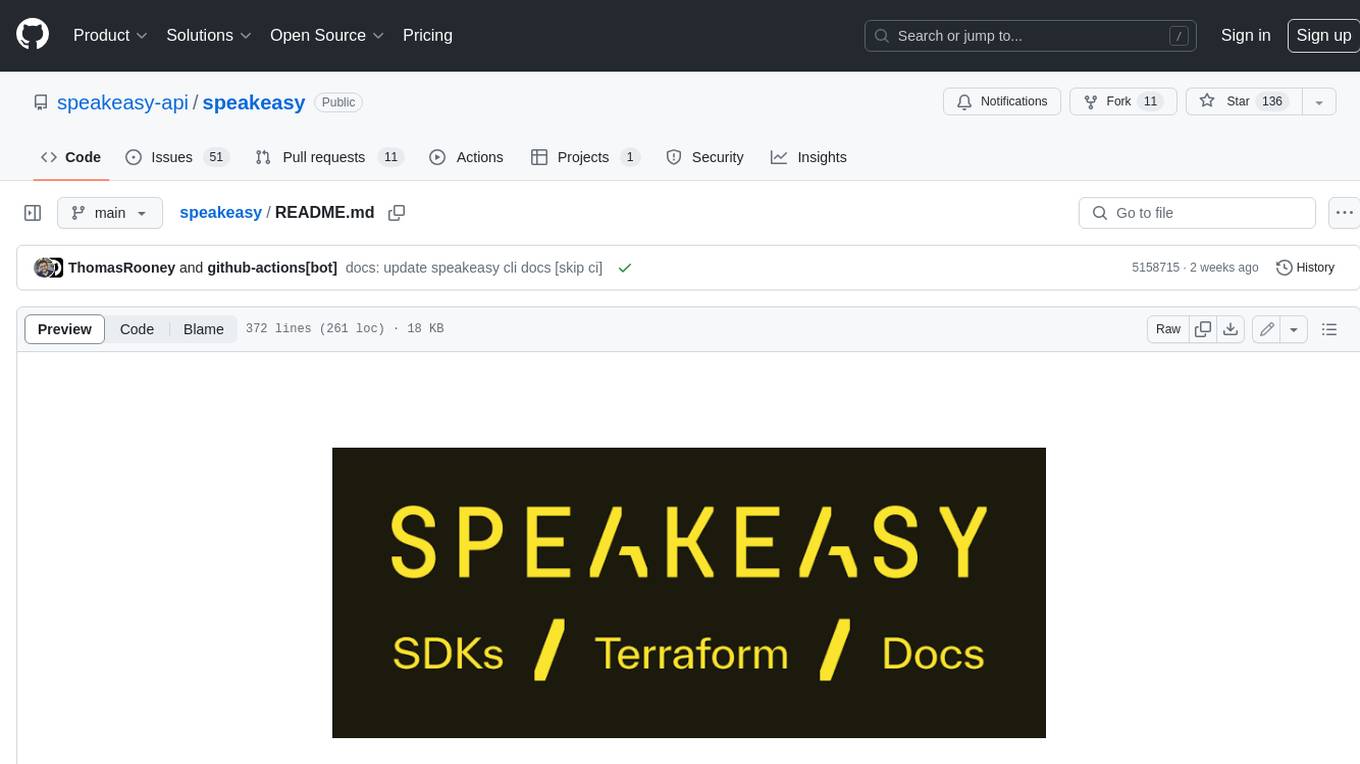
speakeasy
Speakeasy is a tool that helps developers create production-quality SDKs, Terraform providers, documentation, and more from OpenAPI specifications. It supports a wide range of languages, including Go, Python, TypeScript, Java, and C#, and provides features such as automatic maintenance, type safety, and fault tolerance. Speakeasy also integrates with popular package managers like npm, PyPI, Maven, and Terraform Registry for easy distribution.
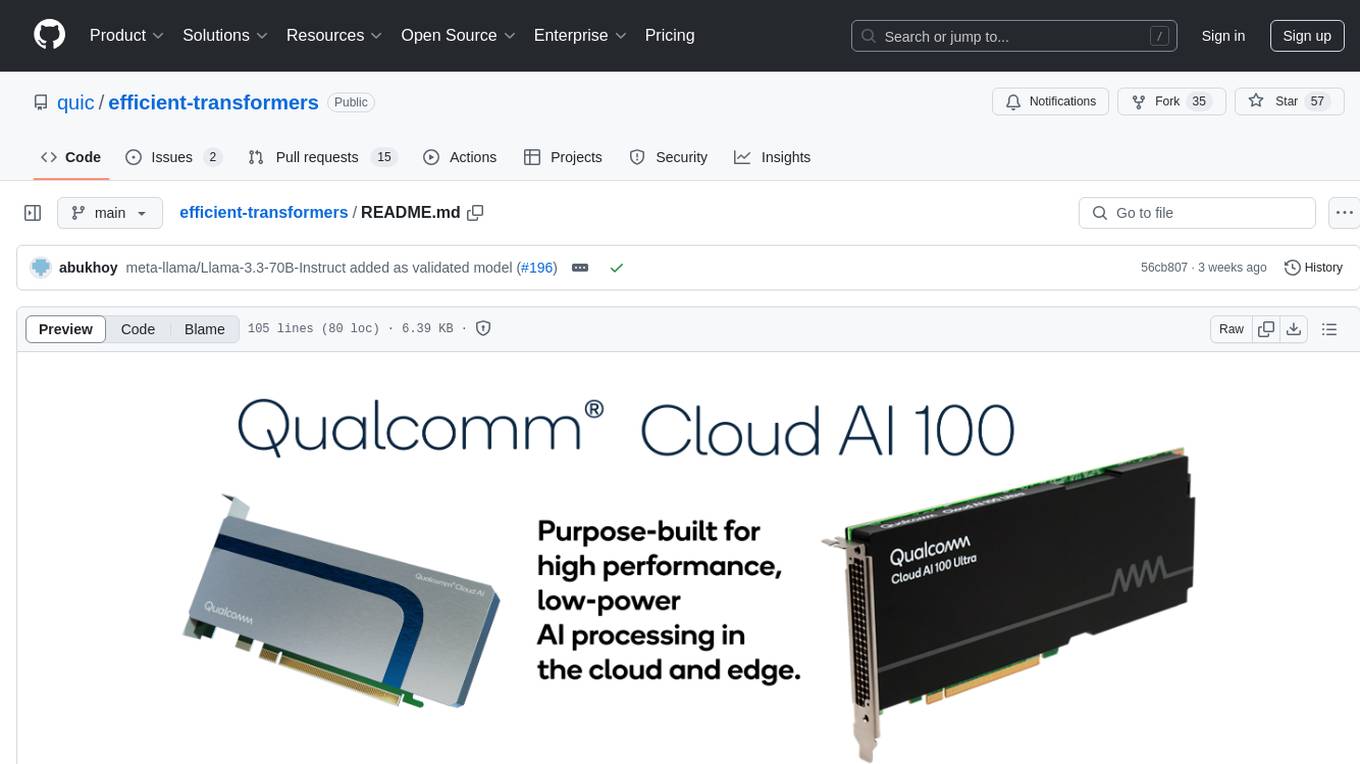
efficient-transformers
Efficient Transformers Library provides reimplemented blocks of Large Language Models (LLMs) to make models functional and highly performant on Qualcomm Cloud AI 100. It includes graph transformations, handling for under-flows and overflows, patcher modules, exporter module, sample applications, and unit test templates. The library supports seamless inference on pre-trained LLMs with documentation for model optimization and deployment. Contributions and suggestions are welcome, with a focus on testing changes for model support and common utilities.
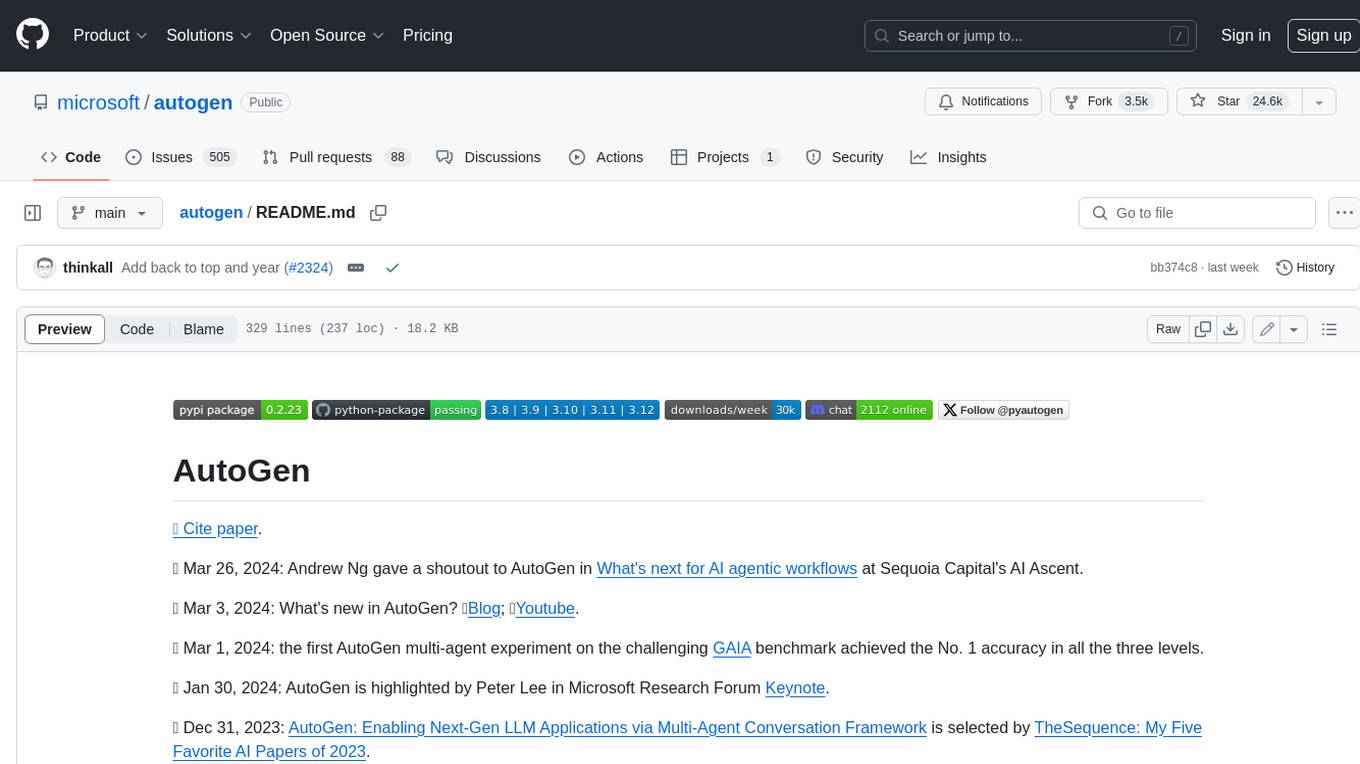
autogen
AutoGen is a framework that enables the development of LLM applications using multiple agents that can converse with each other to solve tasks. AutoGen agents are customizable, conversable, and seamlessly allow human participation. They can operate in various modes that employ combinations of LLMs, human inputs, and tools.
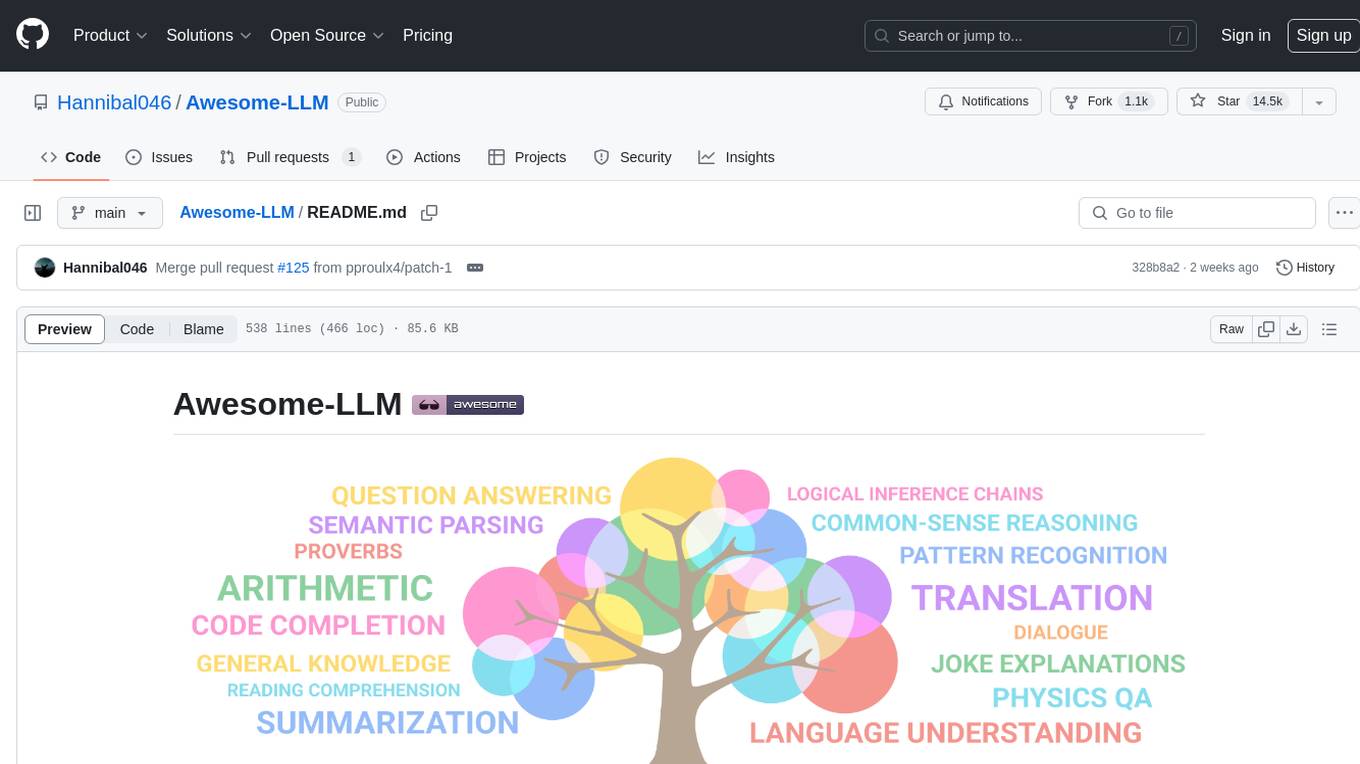
Awesome-LLM
Awesome-LLM is a curated list of resources related to large language models, focusing on papers, projects, frameworks, tools, tutorials, courses, opinions, and other useful resources in the field. It covers trending LLM projects, milestone papers, other papers, open LLM projects, LLM training frameworks, LLM evaluation frameworks, tools for deploying LLM, prompting libraries & tools, tutorials, courses, books, and opinions. The repository provides a comprehensive overview of the latest advancements and resources in the field of large language models.

Awesome-Colorful-LLM
Awesome-Colorful-LLM is a meticulously assembled anthology of vibrant multimodal research focusing on advancements propelled by large language models (LLMs) in domains such as Vision, Audio, Agent, Robotics, and Fundamental Sciences like Mathematics. The repository contains curated collections of works, datasets, benchmarks, projects, and tools related to LLMs and multimodal learning. It serves as a comprehensive resource for researchers and practitioners interested in exploring the intersection of language models and various modalities for tasks like image understanding, video pretraining, 3D modeling, document understanding, audio analysis, agent learning, robotic applications, and mathematical research.
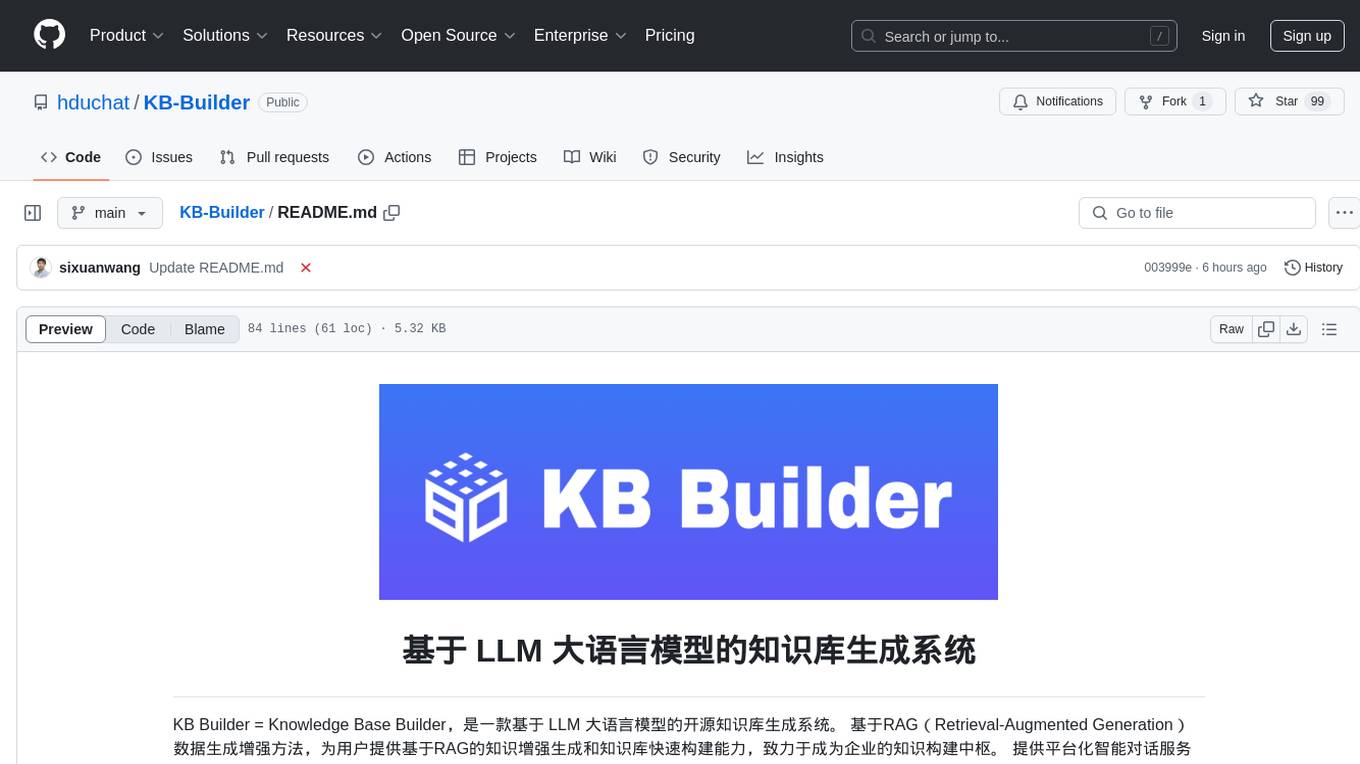
KB-Builder
KB Builder is an open-source knowledge base generation system based on the LLM large language model. It utilizes the RAG (Retrieval-Augmented Generation) data generation enhancement method to provide users with the ability to enhance knowledge generation and quickly build knowledge bases based on RAG. It aims to be the central hub for knowledge construction in enterprises, offering platform-based intelligent dialogue services and document knowledge base management functionality. Users can upload docx, pdf, txt, and md format documents and generate high-quality knowledge base question-answer pairs by invoking large models through the 'Parse Document' feature.
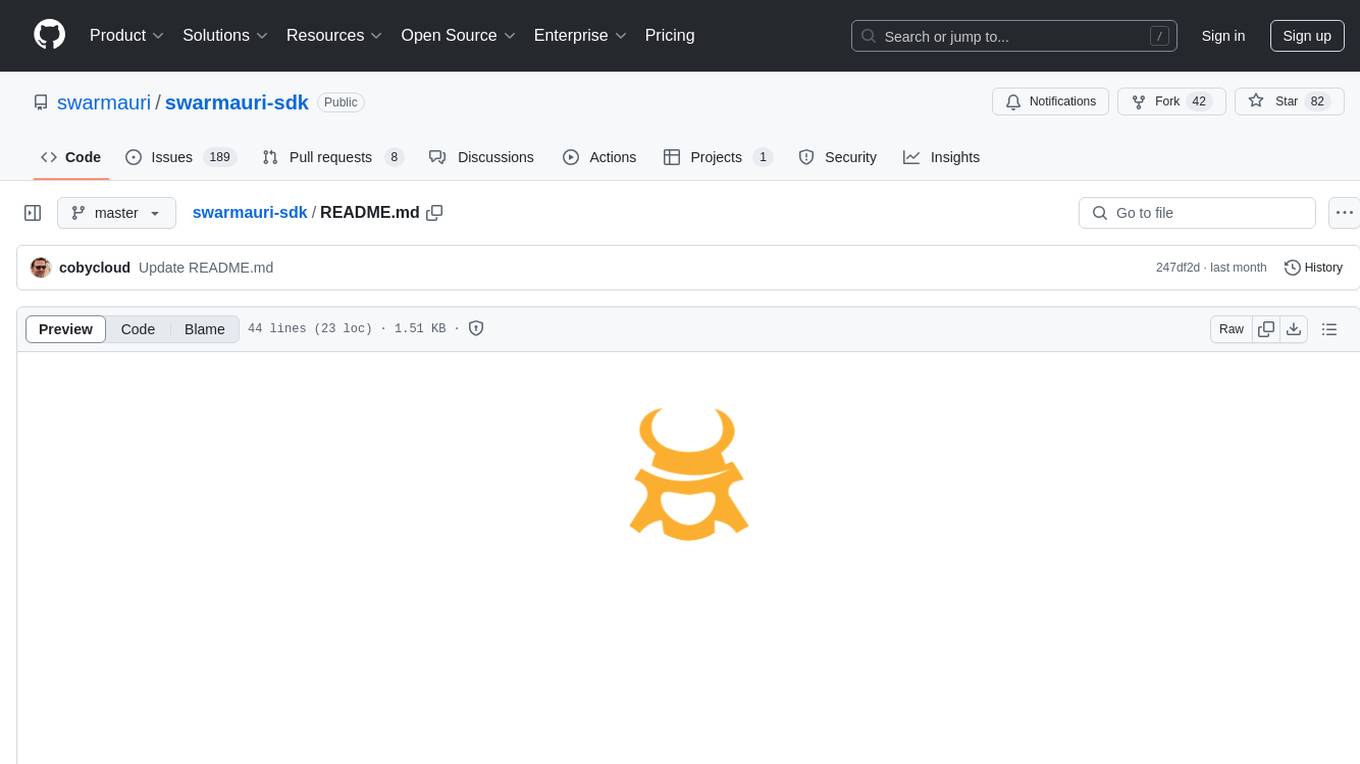
swarmauri-sdk
Swarmauri SDK is a repository containing core interfaces, standard ABCs, and standard concrete references of the SwarmaURI Framework. It provides a set of tools and functionalities for developers to work with the SwarmaURI ecosystem. The SDK aims to streamline the development process and enhance the interoperability of applications within the framework. Developers can easily integrate SwarmaURI features into their projects by leveraging the resources available in this repository.
For similar tasks

Steel-LLM
Steel-LLM is a project to pre-train a large Chinese language model from scratch using over 1T of data to achieve a parameter size of around 1B, similar to TinyLlama. The project aims to share the entire process including data collection, data processing, pre-training framework selection, model design, and open-source all the code. The goal is to enable reproducibility of the work even with limited resources. The name 'Steel' is inspired by a band '万能青年旅店' and signifies the desire to create a strong model despite limited conditions. The project involves continuous data collection of various cultural elements, trivia, lyrics, niche literature, and personal secrets to train the LLM. The ultimate aim is to fill the model with diverse data and leave room for individual input, fostering collaboration among users.

stable-pi-core
Stable-Pi-Core is a next-generation decentralized ecosystem integrating blockchain, quantum AI, IoT, edge computing, and AR/VR for secure, scalable, and personalized solutions in payments, governance, and real-world applications. It features a Dual-Value System, cross-chain interoperability, AI-powered security, and a self-healing network. The platform empowers seamless payments, decentralized governance via DAO, and real-world applications across industries, bridging digital and physical worlds with innovative features like robotic process automation, machine learning personalization, and a dynamic cross-chain bridge framework.

LLaVA-OneVision-1.5
LLaVA-OneVision 1.5 is a fully open framework for democratized multimodal training, introducing a novel family of large multimodal models achieving state-of-the-art performance at lower cost through training on native resolution images. It offers superior performance across multiple benchmarks, high-quality data at scale with concept-balanced and diverse caption data, and an ultra-efficient training framework with support for MoE, FP8, and long sequence parallelization. The framework is fully open for community access and reproducibility, providing high-quality pre-training & SFT data, complete training framework & code, training recipes & configurations, and comprehensive training logs & metrics.
For similar jobs

sweep
Sweep is an AI junior developer that turns bugs and feature requests into code changes. It automatically handles developer experience improvements like adding type hints and improving test coverage.

teams-ai
The Teams AI Library is a software development kit (SDK) that helps developers create bots that can interact with Teams and Microsoft 365 applications. It is built on top of the Bot Framework SDK and simplifies the process of developing bots that interact with Teams' artificial intelligence capabilities. The SDK is available for JavaScript/TypeScript, .NET, and Python.

ai-guide
This guide is dedicated to Large Language Models (LLMs) that you can run on your home computer. It assumes your PC is a lower-end, non-gaming setup.

classifai
Supercharge WordPress Content Workflows and Engagement with Artificial Intelligence. Tap into leading cloud-based services like OpenAI, Microsoft Azure AI, Google Gemini and IBM Watson to augment your WordPress-powered websites. Publish content faster while improving SEO performance and increasing audience engagement. ClassifAI integrates Artificial Intelligence and Machine Learning technologies to lighten your workload and eliminate tedious tasks, giving you more time to create original content that matters.

chatbot-ui
Chatbot UI is an open-source AI chat app that allows users to create and deploy their own AI chatbots. It is easy to use and can be customized to fit any need. Chatbot UI is perfect for businesses, developers, and anyone who wants to create a chatbot.

BricksLLM
BricksLLM is a cloud native AI gateway written in Go. Currently, it provides native support for OpenAI, Anthropic, Azure OpenAI and vLLM. BricksLLM aims to provide enterprise level infrastructure that can power any LLM production use cases. Here are some use cases for BricksLLM: * Set LLM usage limits for users on different pricing tiers * Track LLM usage on a per user and per organization basis * Block or redact requests containing PIIs * Improve LLM reliability with failovers, retries and caching * Distribute API keys with rate limits and cost limits for internal development/production use cases * Distribute API keys with rate limits and cost limits for students

uAgents
uAgents is a Python library developed by Fetch.ai that allows for the creation of autonomous AI agents. These agents can perform various tasks on a schedule or take action on various events. uAgents are easy to create and manage, and they are connected to a fast-growing network of other uAgents. They are also secure, with cryptographically secured messages and wallets.

griptape
Griptape is a modular Python framework for building AI-powered applications that securely connect to your enterprise data and APIs. It offers developers the ability to maintain control and flexibility at every step. Griptape's core components include Structures (Agents, Pipelines, and Workflows), Tasks, Tools, Memory (Conversation Memory, Task Memory, and Meta Memory), Drivers (Prompt and Embedding Drivers, Vector Store Drivers, Image Generation Drivers, Image Query Drivers, SQL Drivers, Web Scraper Drivers, and Conversation Memory Drivers), Engines (Query Engines, Extraction Engines, Summary Engines, Image Generation Engines, and Image Query Engines), and additional components (Rulesets, Loaders, Artifacts, Chunkers, and Tokenizers). Griptape enables developers to create AI-powered applications with ease and efficiency.











































-4CAF50?style=for-the-badge)
-0072B8?style=for-the-badge)
-FF5733?style=for-the-badge)
-FF9800?style=for-the-badge)
-4CAF50?style=for-the-badge)
-00BFFF?style=for-the-badge)
-FF5733?style=for-the-badge)
-8E44AD?style=for-the-badge)
-0072B8?style=for-the-badge)
-FF9800?style=for-the-badge)
















